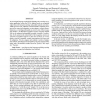Free Online Productivity Tools
i2Speak
i2Symbol
i2OCR
iTex2Img
iWeb2Print
iWeb2Shot
i2Type
iPdf2Split
iPdf2Merge
i2Bopomofo
i2Arabic
i2Style
i2Image
i2PDF
iLatex2Rtf
Sci2ools
ICASSP
2009
IEEE
2009
IEEE
Exploiting user feedback for language model adaptation in meeting recognition
We investigate language model (LM) adaptation in a meeting recognition application, where the LM is adapted based on recognition output from relevant prior meetings and partial manual corrections. Unlike previous work, which has considered either completely unsupervised or supervised adaptation, we investigate a scenario where a human (e.g., a meeting participant) can correct some of the recognition mistakes. We find that recognition accuracy using the adapted LM can be enhanced substantially by partial correction. In particular, if all content words (about half of all recognition errors) are corrected, recognition improves to the same accuracy as if completely error-free (manually created) transcriptions had been used for adaptation. We also compare and combine a variety of adaptation methods, including linear interpolation, unigram marginal adaptation, and a discriminative method based on “positive” and “negative” N-grams.
ICASSP 2009 | Meeting Recognition Application | Partial Manual Corrections | Relevant Prior Meetings | Signal Processing |
| Added | 21 May 2010 |
| Updated | 21 May 2010 |
| Type | Conference |
| Year | 2009 |
| Where | ICASSP |
| Authors | Dimitra Vergyri, Andreas Stolcke, Gökhan Tür |
Comments (0)

